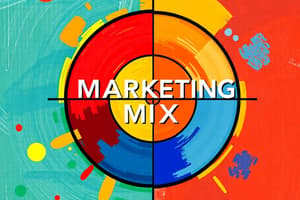Podcast
Questions and Answers
Which action is considered part of the 'meaning of marketing'?
Which action is considered part of the 'meaning of marketing'?
- Handling legal compliance
- Managing human resources
- Promoting and selling products or services (correct)
- Overseeing the company's internal communications
Which of the following is a prerequisite for effective marketing?
Which of the following is a prerequisite for effective marketing?
- Minimizing market research to reduce costs
- Focusing solely on product development
- Ignoring the competition's strategies
- Analyzing market opportunities (correct)
In the context of marketing, what is the primary role of the person/team responsible for 'who does marketing'?
In the context of marketing, what is the primary role of the person/team responsible for 'who does marketing'?
- Managing the company's finances
- Overseeing the production process
- Handling customer service inquiries
- Identifying consumer desires and marketing goods/services accordingly (correct)
Which 'marketing mix' element relates to the monetary cost a customer pays for a product?
Which 'marketing mix' element relates to the monetary cost a customer pays for a product?
Which component of the marketing mix focuses on ensuring a product is available to customers?
Which component of the marketing mix focuses on ensuring a product is available to customers?
Which of the marketing mix is best described as efforts by a company to inform customers about product advantages?
Which of the marketing mix is best described as efforts by a company to inform customers about product advantages?
In healthcare marketing, what distinguishes a 'need' from a 'want'?
In healthcare marketing, what distinguishes a 'need' from a 'want'?
Which activity is most crucial to determine if a health service meets customer needs vs. wants?
Which activity is most crucial to determine if a health service meets customer needs vs. wants?
Which of the following best describes the primary emphasis of companies during the 'Production Era' of marketing?
Which of the following best describes the primary emphasis of companies during the 'Production Era' of marketing?
What characterizes the shift from the Production Era to the Sales Era in marketing?
What characterizes the shift from the Production Era to the Sales Era in marketing?
How did the focus of businesses change during the 'Marketing Era' that began roughly in the mid-1950s?
How did the focus of businesses change during the 'Marketing Era' that began roughly in the mid-1950s?
Which concept is most central to the 'Holistic Marketing Era'?
Which concept is most central to the 'Holistic Marketing Era'?
Which facet is part of the 'Marketing Concept/Culture Era'?
Which facet is part of the 'Marketing Concept/Culture Era'?
Which of the '5 Ms' relates to the personnel involved in internal environmental forces affecting marketing?
Which of the '5 Ms' relates to the personnel involved in internal environmental forces affecting marketing?
Which element is considered part of a company's 'micro environment'?
Which element is considered part of a company's 'micro environment'?
What defines 'market intermediaries' in an external business environment?
What defines 'market intermediaries' in an external business environment?
Which factor is part of the 'demographic environment' in macro marketing?
Which factor is part of the 'demographic environment' in macro marketing?
Which aspect is included in the economic environment?
Which aspect is included in the economic environment?
Which element is considered part of the physical environment?
Which element is considered part of the physical environment?
Which element is part of the technological environment?
Which element is part of the technological environment?
Which factor is part of the 'political-legal' environment?
Which factor is part of the 'political-legal' environment?
Which stakeholders are 'non-marketing driven'?
Which stakeholders are 'non-marketing driven'?
Which of the following is considered a 'market-driven' stakeholder?
Which of the following is considered a 'market-driven' stakeholder?
What is a key characteristic of a 'market-oriented' company?
What is a key characteristic of a 'market-oriented' company?
What is essential for organizational marketing success?
What is essential for organizational marketing success?
Flashcards
Marketing Definition
Marketing Definition
The action of promoting and selling products/services including market research and advertising.
Prerequisites for marketing
Prerequisites for marketing
Analyzing market opportunities, selecting a target market and developing a marketing mix.
Product (Marketing Mix)
Product (Marketing Mix)
The offering (goods or services) to the market by a company.
Price (Marketing Mix)
Price (Marketing Mix)
Signup and view all the flashcards
Place (Marketing Mix)
Place (Marketing Mix)
Signup and view all the flashcards
Promotion (Marketing Mix)
Promotion (Marketing Mix)
Signup and view all the flashcards
Need
Need
Signup and view all the flashcards
Want
Want
Signup and view all the flashcards
Production Era
Production Era
Signup and view all the flashcards
Sales Era
Sales Era
Signup and view all the flashcards
Marketing Era
Marketing Era
Signup and view all the flashcards
Holistic Marketing Era
Holistic Marketing Era
Signup and view all the flashcards
Marketing Concept/Culture Era
Marketing Concept/Culture Era
Signup and view all the flashcards
Internal Environment
Internal Environment
Signup and view all the flashcards
External Environment
External Environment
Signup and view all the flashcards
Suppliers
Suppliers
Signup and view all the flashcards
Market intermediaries
Market intermediaries
Signup and view all the flashcards
Partners
Partners
Signup and view all the flashcards
Customers
Customers
Signup and view all the flashcards
Competitors
Competitors
Signup and view all the flashcards
Public
Public
Signup and view all the flashcards
Macro Environment
Macro Environment
Signup and view all the flashcards
Non-marketing Driven
Non-marketing Driven
Signup and view all the flashcards
Target Market
Target Market
Signup and view all the flashcards
Market-oriented Organization
Market-oriented Organization
Signup and view all the flashcards
Study Notes
- Marketing is the action or business of promoting and selling products or services, including market research and advertising.
- Prerequisites for marketing include: analysis of market opportunities, selection of the target market, and development of a marketing mix.
- The marketing role includes identifying goods and services desired by consumers and marketing those goods and services on behalf of a company.
Marketing Mix Elements
- Product: any offering (goods or services) to the market by a company
- Price: The money customers pay to obtain the product
- Place: Efforts to ensure product availability to customers in the market
- Promotion: Efforts by a company to ensure product sales to customers through information about the product's advantages
Health Care: Needs vs. Wants
- Healthcare professionals are responsible for addressing patients' needs
- Many consumers seek professional responses to their wants
- Need: A condition of deficiency in something
- Want: The wish or desire for something
- Identifying "Who is the Customer?" is essential to uncovering their needs and wants.
Hospital Markets
- Include schools, other hospitals, government agencies, social workers, employers, physicians, judges, nurses, long-term care facilities, managed care organizations, and employees
Evolution of Marketing
- Production Era: Focused on lowering manufacturing costs, lasting from after the U.S. Civil War to the 1920s; operators boosted profits or increased price competitiveness by reducing production costs.
- Sales Era: Followed the production era and lasted roughly twenty years; sales began as people were more connected.
- Marketing Era: Started around the mid-1950s; companies focused on making products customers wanted, shifting from "filling a hole in the factory" to "filling a hole in the market," leading to the rise in market research.
- Holistic Marketing Era: Marketing integrates all aspects of operations to respond effectively to market changes; considers internal awareness of goals, customer focus, and societal impact beyond financial returns.
Marketing Concept/Culture Era
- Focuses on customer orientation, competitor orientation, long-term focus, and profitability.
Environmental Forces Affecting Marketing
- Includes Internal and External Forces
- Internal Environment: Includes factors inside the organization affecting marketing operations, grouped under the Five Ms: Manpower, Money, Machinery, Materials, and Markets.
- The internal environment is controlled by the marketer, and includes sales, marketing, manufacturing, and human resources.
- External Environment: Consists of factors outside the business with little or no control by the marketer.
Micro Environment Constituents
- Suppliers: Provide resources needed by the organization
- Market Intermediaries: Assist in distributing the product or service
- Partners: Separate entities like advertising agencies and research firms
- Customers: The target group
- Competitors: Players in the same market targeting similar customers
- Public: Any group with actual or potential interest affecting the company's ability to serve customers
Macro Environment Divisions
- Demographic: Considers population size, density, location, age, gender, race, and occupation.
- Economic: Influences customer purchasing power and spending patterns, including interest rates, and government funding.
- Physical: Includes the natural environment with climatic conditions and pollution.
- Technological: Includes innovation, research, and technological alternatives
- Political-Legal: Includes laws, government policies, and agencies influencing industry.
- Social-Cultural: Encompasses lifestyle, culture, values, and beliefs.
Planning Processes
- Non-marketing Driven: Involves stakeholders outside the organization with no vested financial interest, such as political grounds and media outlets.
- Marketing Driven: Involves internal stakeholders like owners, investors, and employees, with activities designed to create economic exchange.
Strategic Marketing Process
- Considers stakeholders like customers (patients, physicians)
- Environment includes regulatory, social, technological, economic, and competitive factors
- Society
Target Market
- A specific group of consumers for whom a product or service is designed.
- Market-oriented: The company organizes the activities, products and services to meet the the wants and needs of the customer.
Organizational Marketing Success Requirements
- Listen to customers to identify how to fulfill their needs
- Act on feedback to improve products and communications
Focus on communicating the product's benefits clearly
Prerequisites to Marketing Success include pressure and capacity to be market-oriented, a clear shared Vision of the Market, with actionable First Steps
Changing Health Care Marketplace
- Evolving via the slow process of change
- Accountable Care Organizations (or ACOs) include doctors, hospitals, and health care providers to provide high quality care to Medicare patients voluntairly.
Marketing (4 P's)
- Involves planning and execution of the four marketing mix variables: product, place, promotion, and price
- The marketing mix is the combination of four controllable variables blending them to satisfy the needs of the market.
Studying That Suits You
Use AI to generate personalized quizzes and flashcards to suit your learning preferences.




